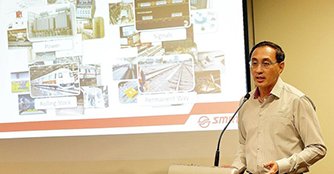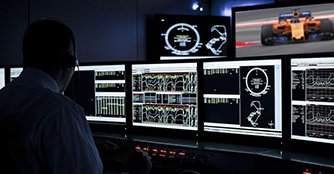New system to help commuters avoid crowds at MRT stations
17 Mar 2018|1,797 views
Commuters will soon be able to find out how crowded an MRT station is even before leaving their homes. An advanced crowd-sensing system - to be put in place at SMRT stations later this year - uses data from various sources such as closed-circuit television cameras and Wi-Fi signals from mobile devices to monitor how crowded platforms are, and how long commuters might have to wait for a train.

Currently, station managers estimate how busy stations are from their own observations and inform commuters about crowds using signs and announcements.
The new system is part of a digitalisation programme SMRT has been developing in its efforts to prevent disruptions and to respond quickly if they occur.
Other initiatives under this programme include the development of a track access management system that automates the allocation of track access to make better use of its engineering hours.
Automating the process would save time and speed up maintenance work, Ms. Chan Lin Yi, a Future Systems Senior Engineer with SMRT, said at a media briefing yesterday. She noted that her team once had to wait for more than three hours after midnight to be granted track access. "There was insufficient time for us to complete our work before train services began. It was a frustrating experience," she said.
Another initiative is a predictive decision support system that monitors various aspects of the rail system and can predict faults before they occur. SMRT's Chief Technology Officer Ng Bor Kiat said the rail operator spared no effort in investing in technology or other resources to improve train journeys, though he was unable to say how much these initiatives cost.

Under SMRT's digitalisation programme, the maintenance operations centre will be upgraded and move from Bishan Depot to Kim Chuan Depot by the end of this year.
The centre will be responsible for all three MRT lines that SMRT operates - the North-South, East-West and Circle lines.
"The adoption of these technologies will enable our people to work smarter, more productively and effectively," said SMRT Chief Executive Officer Desmond Kuek.
He was optimistic that SMRT would be able to hit the reliability target of 1,000,000km between delays of more than five minutes ahead of the 2020 deadline that Transport Minister Khaw Boon Wan set last year. All three SMRT lines showed improved reliability last year.
The Circle Line clocked 523,000km between faults, up from 228,000km in 2016. The North-South and East-West lines - the two oldest MRT lines - clocked 336,000km and 278,000km, up from 156,000km and 145,000km, respectively.
"This is testimony to the relentless efforts by our trains teams in SMRT and LTA (Land Transport Authority) to improve rail reliability," said Mr. Kuek. He added that he will provide an update on SMRT's recent rail performance later this month.
Commuters will soon be able to find out how crowded an MRT station is even before leaving their homes. An advanced crowd-sensing system - to be put in place at SMRT stations later this year - uses data from various sources such as closed-circuit television cameras and Wi-Fi signals from mobile devices to monitor how crowded platforms are, and how long commuters might have to wait for a train.

SMRT CEO Desmond Kuek was optimistic that SMRT would be able to hit the reliability target of 1,000,000km between delays of more than five minutes ahead of the 2020 deadline
Currently, station managers estimate how busy stations are from their own observations and inform commuters about crowds using signs and announcements.
The new system is part of a digitalisation programme SMRT has been developing in its efforts to prevent disruptions and to respond quickly if they occur.
Other initiatives under this programme include the development of a track access management system that automates the allocation of track access to make better use of its engineering hours.
Automating the process would save time and speed up maintenance work, Ms. Chan Lin Yi, a Future Systems Senior Engineer with SMRT, said at a media briefing yesterday. She noted that her team once had to wait for more than three hours after midnight to be granted track access. "There was insufficient time for us to complete our work before train services began. It was a frustrating experience," she said.
Another initiative is a predictive decision support system that monitors various aspects of the rail system and can predict faults before they occur. SMRT's Chief Technology Officer Ng Bor Kiat said the rail operator spared no effort in investing in technology or other resources to improve train journeys, though he was unable to say how much these initiatives cost.

SMRT and McLaren engineers are aiming to adapt race car condition-monitoring technology to assess MRT performance
Under SMRT's digitalisation programme, the maintenance operations centre will be upgraded and move from Bishan Depot to Kim Chuan Depot by the end of this year.
The centre will be responsible for all three MRT lines that SMRT operates - the North-South, East-West and Circle lines.
"The adoption of these technologies will enable our people to work smarter, more productively and effectively," said SMRT Chief Executive Officer Desmond Kuek.
He was optimistic that SMRT would be able to hit the reliability target of 1,000,000km between delays of more than five minutes ahead of the 2020 deadline that Transport Minister Khaw Boon Wan set last year. All three SMRT lines showed improved reliability last year.
The Circle Line clocked 523,000km between faults, up from 228,000km in 2016. The North-South and East-West lines - the two oldest MRT lines - clocked 336,000km and 278,000km, up from 156,000km and 145,000km, respectively.
"This is testimony to the relentless efforts by our trains teams in SMRT and LTA (Land Transport Authority) to improve rail reliability," said Mr. Kuek. He added that he will provide an update on SMRT's recent rail performance later this month.
Latest COE Prices
July 2025 | 2nd BIDDING
NEXT TENDER: 06 Aug 2025
CAT A$101,102
CAT B$119,101
CAT C$68,600
CAT E$120,000
View Full Results Thank You For Your Subscription.



















